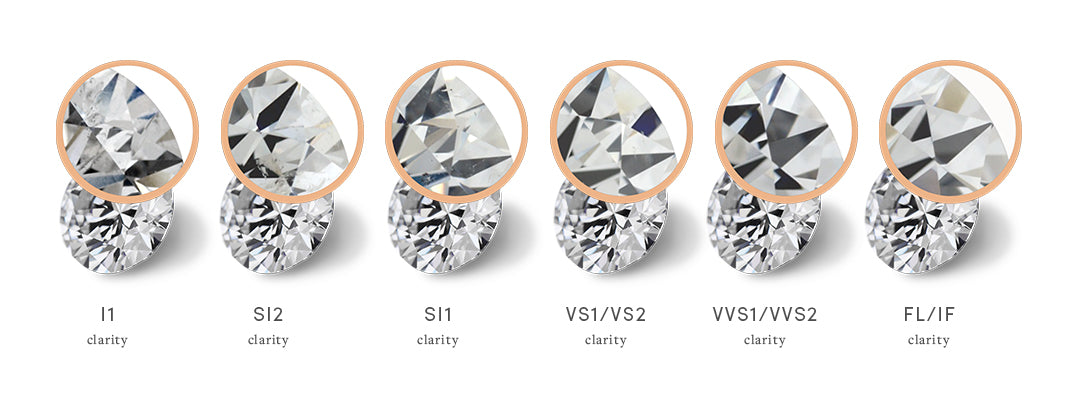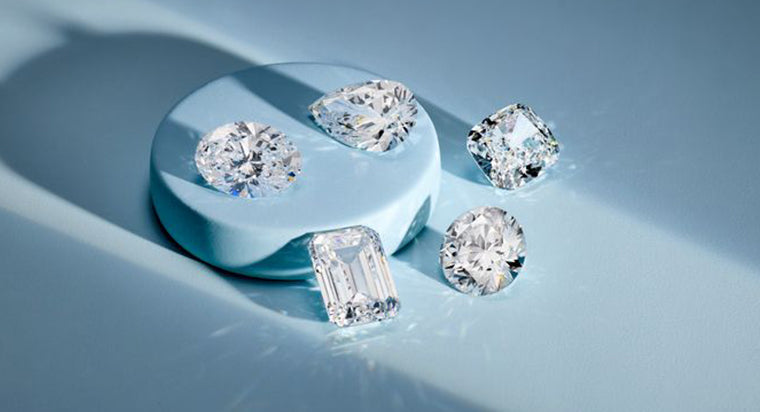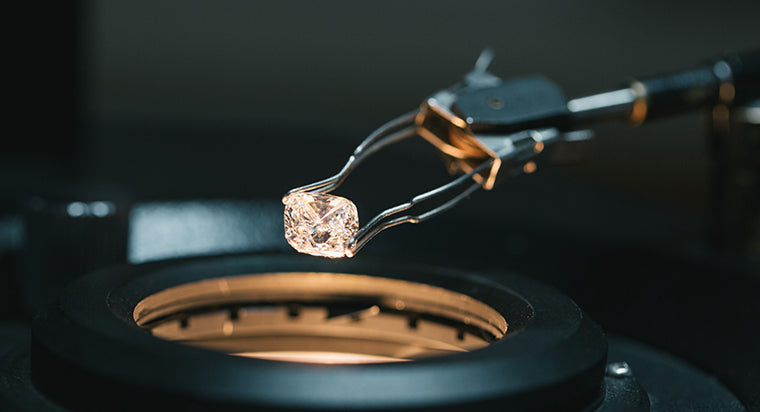Lab Diamond Clarity

They might not be formed in the earth's crust, but lab diamonds are just as stunning as their natural counterparts. They both share the same physical, optical and chemical properties. So it can be almost impossible to tell the two apart!
TABLE OF CONTENTS
What Affects Lab Grown Diamond Clarity?
Both natural and laboratory grown diamonds come in many shapes, sizes, and colors. Traditional white diamonds (which are actually clear) are especially popular. You can find these sparkly gems in necklaces, earrings, and rings (especially engagement rings).
The way in which lab diamonds are formed can affect the clarity of the gem. Let's take a look at the creation process to fully understand how high-quality jewels are made. There are two methods High Pressure-High Temperature (HPHT) and Chemical Vapor Deposition (CVD).
HPHT diamonds are produced via one of the three manufacturing methods as follows. All three, the belt press, the cubic press, and the split-sphere (BARS) press, are used to generate the high pressure and temperature required to encourage diamond growth.
A CVD diamond starts out as a sliver of a diamond seed. The seed is put into a chamber and warmed to approximately 800 degrees. This causes carbon gases such as Methane, to permeate the chamber. Then, plasma technology is employed to ionize the seed and the addition of pure carbon causes it to crystallize.
HPHT and CVD diamonds have different gemological compositions, both processes result in the production of a unique diamond. CVD diamonds sometimes display silicon inclusions and HPHT diamonds are rarely completely colorless.
Is Lab Diamond Clarity better than Natural Diamonds Clarity?
It's virtually impossible to tell the difference between lab created diamonds color and clarity, and that of natural diamonds. They both have the ability to sparkle and dazzle, they both come in different sizes and shapes, and they both have the same qualities in terms of clarity and color.
What Types of Inclusions are There?
An inclusion could be likened to a birthmark - a little unique internal or external blemish on the diamond. Inclusions are caused by the environment in which the diamonds are grown - both the earth's crust and extreme lab temperatures can have the same impact. Therefore, both natural and lab grown diamonds often display inclusions.
How Do Inclusions and Blemishes Affect a Lab diamond's Sparkle?
There is a wide range of inclusions, from noticeable ones that can be seen by the naked eye to inclusions that are difficult to see even when the diamond is magnified.
More obvious inclusions have an impact on how the diamond looks and, to a degree, how much it sparkles.
Most Common Inclusion Types:
Diamond clarity grade depends highly on its inclusions, the types and amount of blemishes it has. There are five common inclusions you should know:
Needle
A needle inclusion resembles a thin, long line. Similar to how a sewing needle looks.
Cloud
Cloud inclusions get their name because, under magnification, it looks like a cluster of pinpoints. Cloud inclusions are within a diamond.
Crystal
Crystal inclusions are seemingly an illusion. Imagine if you were to put a diamond, within a diamond. These inclusions occur during the formation process--where tiny diamond or mineral deposits become trapped inside.
Feather
The second-most common inclusion type--feather. Similar to a needle inclusion, but a feather inclusion has tiny cracks from top to bottom. Sometimes if a feather inclusion is deep enough, it can negatively affect the diamond's structure.
Pinpoint
Out of over a dozen kinds of inclusions, pinpoint inclusions are the most common. Pinpoint inclusions are on the diamond table surface and look like tiny black dots.

What is The IGI Lab Diamond Clarity Scale?
The International Gemological Institute (IGI) was established in 1975. With independent laboratories across the globe and schools offering courses in the art of gemology, IGI is considered a powerhouse in the diamond world.
IGI classifies diamonds in terms of identification, measurements, shape, cut, finish, weight, proportions, clarity, and color. The IGI Identification Report allow potential buyers to understand what type of diamond they are getting for their money.
IGI Clarity Grades Explained
There are a number of grades on the IGI clarity scale: IF, VVS1, VVS2, VS1, VS2, SI1, SI2, I1, I2, I3. These grades indicate the level of any internal and external diamond flaws. A lab grown diamond clarity comparison chart mirrors the grades given to natural diamonds. The grades are:
- I - Included: noticeable.
- SI - Slightly Included: Difficult to see with the naked eye, but can be seen via x10 magnification.
- VS - Very Slightly Included: Flaws can only be seen with x10 magnification.
- VVS - Very, Very Slightly Included: Flaws exist but are difficult to see, even via x10 magnification.
- FL/IF - Flawless / Internally Flawless: No flaws visible, even with x10 magnification.
Sliding scale 1 - 2: Within the main clarity scale, there's also a sliding scale, with level 1 indicating less significant flaws than a level 2.

How Does Clarity Affect Lab Diamond Prices?
Diamond Simulants vs Lab Grown Diamonds
It's important to understand the difference between diamond stimulants and lab grown diamonds. Lab grown diamonds are produced in conditions created to emulate the earth's crust. Therefore, these man made diamonds have the same properties and qualities as natural diamonds.
Simulants, such as cubic zirconia, are very pretty and produced to look like diamonds, but they are actually made of different materials. A lab created diamond simulant with VVS11 Clarity grade and a D Color (colorless) grade, will always cost less than a natural diamond.
Clarity plays its part in pricing and is one of a number of factors. As you would expect, the price of a diamond is determined by its grading.
The higher the clarity rating, the higher the price. There isn't a vast difference between the lower grades e.g. SI to VS, but at VVS or IF levels prices can rise dramatically.
How to Select a Clarity Grade
It's difficult to pinpoint which grade is “best” in terms of clarity. On paper, an IF/FL diamond has the best clarity, and to those with an unlimited budget, buying the best is the only option!
However, most of us do have a budget in mind, and our cash won't stretch to a flawless gem. Luckily, a FL/IF diamond doesn't look any more impressive to the naked eye than a lower grade stone. Buy a diamond that looks amazing and offers good value for money.
FAQs
Do lab grown diamonds have better clarity?
What type of inclusions do lab grown diamonds have?
What clarity are lab diamonds?
Which is the best clarity for a lab grown diamond?









